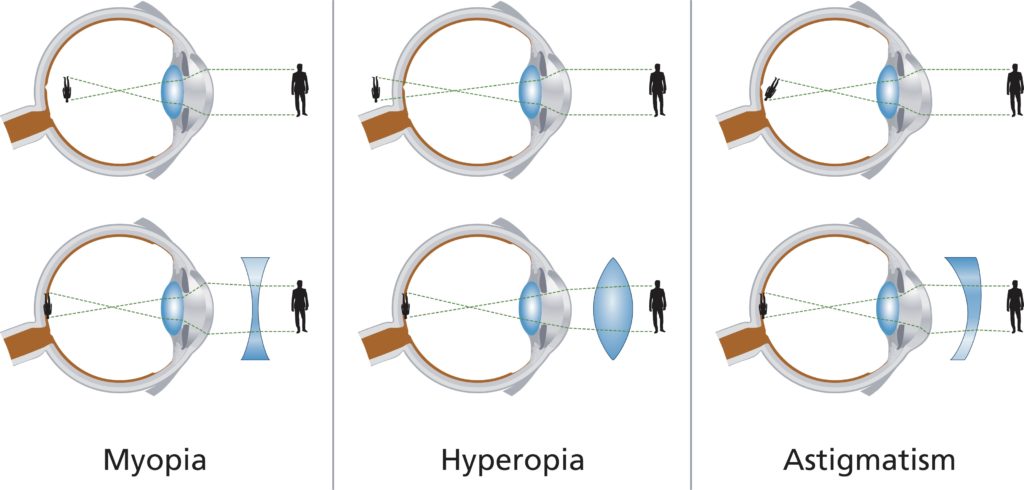Nearsightedness, or myopia, is when the eyes can see objects that are near but not far. However, farsightedness, or hyperopia, is not the exact opposite of nearsightedness. Farsighted eyes can see both near and far if the eyes’ focusing system can work through the prescription, using more effort for near objects. However, if the focusing system does not work well, both near and far objects may be unclear. Astigmatism is when the front surface of the eye has an irregular shape, causing the object to be distorted.

Did you know…Our brain is actually what “sees.” Our eyes are just tools that collect the images from the outside world. Objects and light rays are focused onto the retina upside down, and the retina sends the information to the optic nerve, which then sends the information to the brain. The brain processes the information, then flips the image and that is how we get vision. |
Frequently Asked Questions
Has the technology changed for getting my prescription?
Your optometrist at New Optix Optometry will determine your prescription through digital state-of-the-art equipment. First, he will use an autorefractor, a revolutionary machine that digitally measures your prescription without relying on your responses. Then, your eye doctor will operate an automatic phoropter to accurately measure your prescription. In other words, your optometrist already knows if it is “Better 1 or Better 2.” No longer are the days of the bulky contraption with a bunch of knobs and switches. If necessary, he will build a trial frame, or a mock pair of glasses in your prescription.

What is presbyopia?
Presbyopia is when the natural focusing lens in our eye loses its flexibility. As it hardens with age, we lose our ability to focus objects at near, becoming more farsighted, and needing reading glasses. You cannot escape presbyopia, even if you have never had a vision problem. To correct for both distance and near objects, bifocals or progressive glasses will be prescribed.
How do glasses and contact lenses work?
The prescription of glasses and contact lenses simply move the focal point of objects, in order to focus it on the retina. A minus (-) prescription moves the object back, which corrects nearsightedness. A positive (+) prescription moves the object forward, which corrects farsightedness. Cylinder (Cyl) powers have 2 different prescriptions in each curve, which corrects astigmatism. Astigmatism contact lenses, or toric contacts, have blink stabilizers to rotate the lens to correct the 2 curves of the cornea.
Contact lenses are FDA-mandated medical devices and need to be prescribed by an eyecare professional. They sit on the cornea to correct the vision, so risks of health complications increase. Due to the base curve of the lenses, contacts do not often deviate from the cornea or get dislodged in the eyelid.
New technological advances have made fitting contact lenses for presbyopia easier. Multifocal contact lenses can now focus both distance and near simultaneously with clear, functional vision. Monovision, setting up one eye to see far and the other eye to see near, is also a highly successful modality to correct for presbyopia.
I see fine, do I need an eye exam?
The American Optometric Association recommends that you get an eye exam every year. Though you may see fine, vision testing is only a small portion of a comprehensive eye exam. Eye health checks are part of your annual general wellness and can reveal conditions that would not be detected otherwise.
I have great vision, why are glasses recommended?
Farsightedness is a unique vision condition because the eye’s natural focusing system can adjust for it. The lens inside the eye is able to move an object forward, just like a positive (+) prescription of glasses or contacts. However, that is a lot of strain for the system to maintain good vision, so your optometrist may recommend glasses to relieve the stress.
Will I become dependent on my glasses?
Glasses do not have any addictive properties. They simply focus objects onto the retina so the brain sees clear and comfortably. Wearing glasses do not prevent any changes to your vision. Not wearing glasses also do not prevent any changes to your vision. Your vision changes regardless, but glasses do reduce eye strain and allow the best vision.